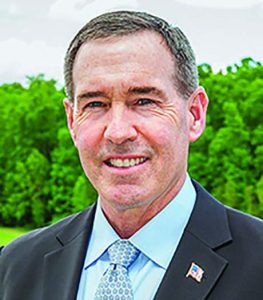by Joseph P. Tartaro | Executive Editor

Christopher J. Killoy
Sturm, Ruger & Co. made it official by announcing the promotion of the company’s president, Christopher J. Killoy, to serve as both president and chief executive officer (CEO), effective May 9, 2017, the day of his predecessor Michael O. Fifer’s retirement. The gun and ammunition manufacturing company had previously announced that Killoy’s duties would expand on August 2, 2016.
During his career, Christopher Killoy has held several leadership roles in the firearms industry. Prior to joining Ruger in 2006, he served as vice president of sales and marketing for Smith & Wesson, and as vice president and general manager of Savage Range Systems.
Killoy joined Ruger in November 2006 as vice president of sales and marketing and was promoted to president and chief operating officer (COO) in January 2014. He is a 1981 graduate of the United States Military Academy at West Point and subsequently served in a variety of armor and Infantry assignments in the US Army.
Chris Killoy is the fourth CEO in the Ruger firm’s 68-year history, succeeding William B. Ruger (1949 – 2000), William B. Ruger, Jr. (2000 – 2006), and Fifer (2006 – 2017).
“Chris Killoy is the perfect choice to be Ruger’s next CEO,” said Ruger Board Chairman C. Michael Jacobi. “His distinguished 30-year career in the firearms industry, including his exemplary service to Ruger for nearly a decade, is a testament to his experience, character and leadership, all of which make him the ideal candidate to lead Ruger.”
“I am truly honored to be selected by the Board of Directors to further expand my leadership role with such a fine company,” said Killoy. “It has been a privilege working closely with and learning from Mike Fifer for over a decade. I am proud of all that we accomplished together and I look forward to the opportunity to take the reins at such an exciting time at Ruger.”
The succession announced followed by a day Sturm, Ruger’s first quarter financial report, declaring that for the first quarter of 2017 the company had net sales of $167.4 million and diluted earnings of $1.21 per share, compared with net sales of $173.1 million and diluted earnings of $1.21 per share in the first quarter of 2016.
The company also announced that its Board of Directors declared a dividend of 48¢ per share for the first quarter for stockholders of record as of May 19, 2017, payable on May 31, 2017. This dividend varies every quarter because the company pays a percentage of earnings rather than a fixed amount per share. This dividend is approximately 40% of net income.
In addition, Sturm, Ruger announced that its Board of Directors expanded its authorization to repurchase shares of its common stock to $100 million. The previous authorization was depleted by the recent share repurchases.
As part of the financial report, outgoing CEO Michael O. Fifer made the following observations related to the company’s 2017 first quarter performance:
- In the first quarter of 2017, net sales decreased 3% and earnings per share remained unchanged from the first quarter of 2016.
- EBITDA was $43.6 million, or 26% of sales, in the first quarter of 2017, a decrease of 3% from $44.8 million, or 26% of sales, in the comparable prior year period.
- Sales of new products, including the Mark IV pistols, the LCP II pistol, and the Precision Rifle, represented $41.5 million or 25% of firearm sales in the first quarter of 2017. New product sales include only major new products that were introduced in the past two years.
- The estimated unit sell-through of the company’s products from the independent distributors to retailers decreased 7% in the first quarter of 2017 from the comparable prior year period. For the same period, the National Instant Criminal Background Check System background checks (as adjusted by the National Shooting Sports Foundation) decreased 11%.
- The decrease in estimated sell-through of the company’s products from the independent distributors to retailers is attributable to: ◦Decreased overall consumer demand in the first quarter of 2017 due to stronger-than-normal demand during most of 2016, likely bolstered by the political campaigns for the November 2016 elections.
While much of the general media has been dramatizing a decline in firearms sales since President Barack Obama left office, they seem to be overlooking other factors relating to the general health of the industry. The eight-year presidency of one of the most anti-gun presidents in American history was not the only factor driving record sales during the last few years.
Contributing to those high rates of firearms purchases were: a growing interest in the value of firearms ownership for defense and recreation exhibited by younger people, particularly women, and minorities, as well as continuing concerns about the threat of terrorist attacks, which makes headlines every month.
The growing number of shooting ranges in urban areas and the increase in the number of qualified professional firearms training schools are excellent indicators of the general health of the firearms business this year. In addition, while the number of NICS checks reported is slightly lower than in was in the last year of the Obama administration, the numbers are still running way ahead of comparable figures from 2008-2012.
What seems to bother some firearms and ammunition retailers these days are the continuing shift in sales toward online retailers as opposed to brick and mortar stores.



